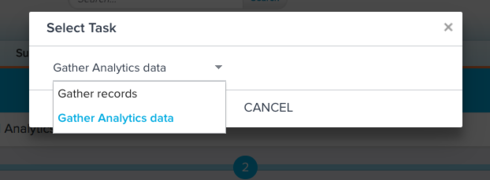New Idea
ONE task output is required when trying to setup actions on outputs of multiple tasks
I was working with a services architect and we tried creating a rule that had two dataset tasks that fell under the same general umbrella of what I wanted this rule to do - even though they were two disparate sets of data. I didn't need to merge the data, I just needed the two sets to be available.
When I got to the Setup Action screen, I got an error message: "It is mandatory to have only one output task to execute actions. Ensure to use Merge task, if there are more than one output tasks."
The documentation isn't clear, but engineering told me that you have to only have ONE task output in order to create actions. But as long as you have only ONE task output - you can still select any of the dataset tasks upon which to perform an action. Which seems like you're forced to take an extra step of creating a merge, when you don't really need the data to be merged to accomplish your goal.
Incidentally, if you have two datasets + 1 merge, and two more datasets + 1 merge, you then have to merge the two merges. THEN you can select any of the dataset tasks or merge tasks and perform an action off of them.
As long as there is only one ultimate output from all the Tasks, you can use any task to deliver an action.
REQUEST #1: Can the documentation be updated to more clearly explain this requirement?
QUESTION: Is there a reason why that single output requirement is necessary?
I will add that when I have only two dataset tasks (which would result in two outputs) I get the error message cited above BUT I can still select one of those two tasks, create an action, and attempt to run the rule (which subsequently fails immediately because of the dual task outputs).
REQUEST #2: If the single output requirement remains a requirement, then you should probably restrict someone from being able to do what I did above. If there are multiple outputs from the Tasks, then I shouldn't be able to select a task upon which to create an action.
When I got to the Setup Action screen, I got an error message: "It is mandatory to have only one output task to execute actions. Ensure to use Merge task, if there are more than one output tasks."
The documentation isn't clear, but engineering told me that you have to only have ONE task output in order to create actions. But as long as you have only ONE task output - you can still select any of the dataset tasks upon which to perform an action. Which seems like you're forced to take an extra step of creating a merge, when you don't really need the data to be merged to accomplish your goal.
Incidentally, if you have two datasets + 1 merge, and two more datasets + 1 merge, you then have to merge the two merges. THEN you can select any of the dataset tasks or merge tasks and perform an action off of them.
As long as there is only one ultimate output from all the Tasks, you can use any task to deliver an action.
REQUEST #1: Can the documentation be updated to more clearly explain this requirement?
QUESTION: Is there a reason why that single output requirement is necessary?
I will add that when I have only two dataset tasks (which would result in two outputs) I get the error message cited above BUT I can still select one of those two tasks, create an action, and attempt to run the rule (which subsequently fails immediately because of the dual task outputs).
REQUEST #2: If the single output requirement remains a requirement, then you should probably restrict someone from being able to do what I did above. If there are multiple outputs from the Tasks, then I shouldn't be able to select a task upon which to create an action.
Sign up
If you ever had a profile with us, there's no need to create another one.
Don't worry if your email address has since changed, or you can't remember your login, just let us know at community@gainsight.com and we'll help you get started from where you left.
Else, please continue with the registration below.
Welcome to the Gainsight Community
Enter your E-mail address. We'll send you an e-mail with instructions to reset your password.






